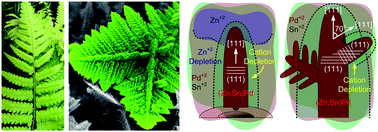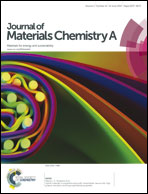Growing metal trees on tubular semiconductor land: TiO2/(Zn,Sn)Pd heterostructures with high SERS and photocatalytic activity†
Abstract
By using sacrificial ZnO nanorods, a self non-uniform electric field was established to yield the aqueous growth of 〈111〉 oriented, single-crystalline (Zn,Sn)-doped Pd nanodendrites on TiO2 nanotubes for synthesizing three-dimensional hydrophobic heterostructures. Structural analyses revealed that primary dendrite arms grew along a 〈111〉 direction group; symmetric branches were built on the basal plane of the arms but sprouted in another [111] direction, similar to a twin structure. Sequential growth processes different from a diffusion-limited aggregation model were suggested, including the dissolution of ZnO nanorods for forming a self non-uniform electric field, the protruding of primary arms towards a Zn2+ concentrated zone, and then the development of branches through a cation depletion zone. A strong surface enhanced Raman scattering and high photocatalytic activity, owing to the strong surface plasmon resonance on the large-surface symmetric structures and the inhibited recombination of photogenerated electron–hole pairs, suggested the high potential of the heterostructures for applications in self-cleaning photocatalysts and nano-optoelectronic devices.


 Please wait while we load your content...
Please wait while we load your content...